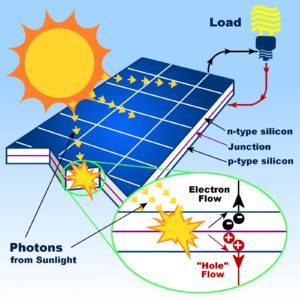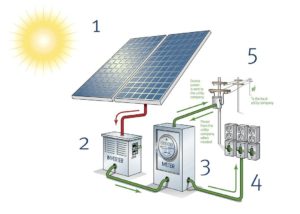Solar Power Overview
What is Solar Power?
![]() Simply put, it’s a way to extract energy from the sun! Solar power is the conversion of sunlight into electricity, either directly using photovoltaics (PV), or indirectly using concentrated solar power (CSP). Photovoltaics convert light into an electric current using the “photovoltaic effect”. Concentrated solar power systems use lenses or mirrors and tracking systems to focus a large area of sunlight into a small beam. The International Energy Agency projected in 2014 that under its “high renewables” scenario, by 2050, solar photovoltaics and concentrated solar power would contribute about 16 and 11 percent, respectively, of the worldwide electricity consumption, and solar would be the world’s largest source of electricity!
Simply put, it’s a way to extract energy from the sun! Solar power is the conversion of sunlight into electricity, either directly using photovoltaics (PV), or indirectly using concentrated solar power (CSP). Photovoltaics convert light into an electric current using the “photovoltaic effect”. Concentrated solar power systems use lenses or mirrors and tracking systems to focus a large area of sunlight into a small beam. The International Energy Agency projected in 2014 that under its “high renewables” scenario, by 2050, solar photovoltaics and concentrated solar power would contribute about 16 and 11 percent, respectively, of the worldwide electricity consumption, and solar would be the world’s largest source of electricity!
Photovoltaics
 A photovoltaic power system “PV system” is designed to supply usable solar power by means of photovoltaics. It consists of an arrangement of several components, including a solar panel array to absorb and convert sunlight into electricity, a solar inverter, as well as mounting, cabling and other electrical accessories to set up a working system. The array of a photovoltaic system produces direct current (DC) power which fluctuates with the sunlight’s intensity. For practical use, this usually requires conversion to certain desired voltages, or alternating current (AC), through the use of inverters. Photovoltaic system capacities range from a few kilowatts to hundreds of megawatts.
A photovoltaic power system “PV system” is designed to supply usable solar power by means of photovoltaics. It consists of an arrangement of several components, including a solar panel array to absorb and convert sunlight into electricity, a solar inverter, as well as mounting, cabling and other electrical accessories to set up a working system. The array of a photovoltaic system produces direct current (DC) power which fluctuates with the sunlight’s intensity. For practical use, this usually requires conversion to certain desired voltages, or alternating current (AC), through the use of inverters. Photovoltaic system capacities range from a few kilowatts to hundreds of megawatts.
Operating silently and without any moving parts or environmental emissions, a PV system can recoup the invested energy for its manufacturing and installation within 0.7 to 2 years and produces about 95 percent of net clean renewable energy over a 30-year service lifetime. In exceptionally irradiated locations, or when thin-film technology is used, the so-called energy payback time decreases to one year or less.
Driven by advances in technology and increases in manufacturing scale and sophistication, the cost of photovoltaics has declined steadily since the first solar cells were manufactured, and in many countries it is cheaper than ordinary fossil fuel electricity from the grid (there is “grid parity”). Solar PV is now, after hydro and wind power, the third most important renewable energy source in terms of globally installed capacity. More than 100 countries use solar PV. In 2014, worldwide installed PV capacity increased to at least 177 gigawatts, sufficient to supply 1 percent of global electricity demands.
Photovoltaic Effect
 A photovoltaic system employs solar panels composed of a number of solar cells to supply usable solar power. The process is both physical and chemical in nature, as the first step involves the “photoelectric effect” from which a second electrochemical process takes place involving crystallized atoms being ionized in a series, generating an electric current. Power generation from solar PV has long been seen as a clean, sustainable energy technology which draws upon the planet’s most plentiful and widely distributed renewable energy source – the sun. It is well proven, as photovoltaic systems have now been used for fifty years in specialized applications, and grid-connected PV systems have been in use for over twenty years.
A photovoltaic system employs solar panels composed of a number of solar cells to supply usable solar power. The process is both physical and chemical in nature, as the first step involves the “photoelectric effect” from which a second electrochemical process takes place involving crystallized atoms being ionized in a series, generating an electric current. Power generation from solar PV has long been seen as a clean, sustainable energy technology which draws upon the planet’s most plentiful and widely distributed renewable energy source – the sun. It is well proven, as photovoltaic systems have now been used for fifty years in specialized applications, and grid-connected PV systems have been in use for over twenty years.
Most solar modules are currently produced from crystalline silicon (c-Si) solar cells made of multicrystalline and monocrystalline silicon. They produce a relatively high-efficiency conversion for the low cost compared to other solar technologies.
You can review the graphic below for an overview of how the solar process works (click to enlarge).

| 1. Sunlight falls on high capacity solar panels during daylight hours. The solar panels convert the sun’s energy into Direct Current (DC) electricity which is sent to an inverter. | |
| 2. The inverter converts the Direct Current into Alternating Current (AC) electricity. This is sometimes called “conditioning” the power. | |
| 3.When the solar energy system produces more electricity than is needed during peak sun hours, excess electricity can be stored, or sent to the grid for consumption. | |
| 4.Solar energy systems produce very high quality electricity that reduces the chance of power fluctuations that could damage electronic equipment. | |
| 5. Other renewable power generation can suppliment the solar system during times of low sunlight or when demand exceeds production. |
